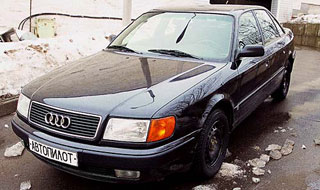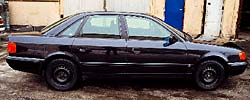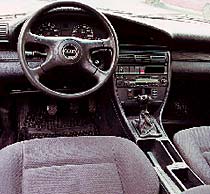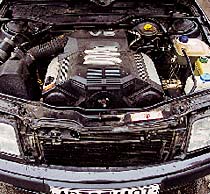Test drive Audi 100 C4 1991 - 1994 sedan
$8500
 Need German, equipped, with a powerful engine, unstable and not very expensive car? This is Audi 100.
Need German, equipped, with a powerful engine, unstable and not very expensive car? This is Audi 100. This model is the third and last generation with an index of 100. It was produced from November 1990 to 1994, then a radical restyling was carried out, and since 1995 A6 has already gone. The last hundredth was produced in sedan bodies (Limousine) and a station wagon (Avant), with front or full (QUATTRO) drive, mechanical or automatic gearbox and a whole gamut of engines: 4-cylinder 16-valve volume of 2.0 liters with ABK index, 5- cylinder 2.3-liter (AAR), two 6-cylinder V-shaped volume of 2.8 liters (AAN) and 2.6 liters (since 1992-ABC, since 1993-ACZ). And at the end of 1991, a charged version appeared under the S4 index with a 2.2-liter 5-cylinder turbo engine and only all-wheel drive. And since 1993, a 4.2-liter eight with a capacity of 280 hp began to install in version S4. The diesel was also in the range, but they are very rare in Russia.
 Sexual characteristics. Before proceeding with a virtual examination of the machine, we will make a small digression: firstly, the common opinion that three letters Z in Vins indicate some kind of special zinc coating is absolutely incorrect. These are only official signs, and the body is completely galvanized for everyone.
Sexual characteristics. Before proceeding with a virtual examination of the machine, we will make a small digression: firstly, the common opinion that three letters Z in Vins indicate some kind of special zinc coating is absolutely incorrect. These are only official signs, and the body is completely galvanized for everyone. Let's start with identification nameplates. The main, metallic, glued in the middle of the right wing amplifier in the engine compartment. It should be black. You will find a duplicate paper sticker in the trunk. VIN is knocked out in the upper part of the motor shield in the center. The presence and appearance of the nameplate allow us to judge whether the machine has been subjected to body repair. You should also pay special attention to the bubbles of paint, under which the rust is usually hidden. Do not be lazy, remove the trunk skin and look at the inside of the wings and floor. She can store obvious traces of work on herself. The surfaces poured under the hood, an unevenly standing block of the ABS hydraulic engine and/or bent tubes coming from it, as well as a crooked -fixed washer tank or additional holes are not allowed.
 Clear eyes. Third -generation hundred in our market, as a rule, are offered with a rich set of options. We sit in the driver's seat and examine them carefully. All control lamps and lighting lamps should, of course, work. They change quickly and inexpensively, with the exception of a small thermometer display. Do not believe the seller - here we are not talking about a penny bulb, but about the whole device (up to $ 100). Check the work of heating the seats - the heating element costs almost $ 100, and the replacement work is $ 65. Pay attention to the heater fan - it should work absolutely silently. If it squeaks or creaks, especially at low speed - enter in the account before $ 160 per engine and up to $ 110 for replacement. In cars with climate control, special attention should be paid to the operation of the temperature damper. If when you press the corresponding button, the air temperature does not change, we enter $ 105 into our small account (+$ 65 for work). The same applies to the servomotor of the shutters that control the air flow. The spool is small, but biting - a little less than $ 100 and about $ 90 for work. It is also useful to look at the windows control unit. It is located on the left below at the front rack, at the legs of the driver. If the windows do not work normally, the glass move with jerks - perhaps the replacement of the block is close. This box will cost dollars in 170. In the end, we turn to the instruments. A twitching arrow or a non -working speedometer will allow us to bring $ 320 more to our discount cowl for a new plus $ 56 for work. And if you saw that the arrow of the engine temperature indicator is alive - it shows more or less - do not believe the applications about the penny sensor. This little thing will cost about $ 75. The same applies to the fuel indicator. Here, however, the options are possible: the elementary soldering of a spilled wiring in the sensor itself (about $ 50 for everything) or replacing the latter - more than $ 100 with work.
Clear eyes. Third -generation hundred in our market, as a rule, are offered with a rich set of options. We sit in the driver's seat and examine them carefully. All control lamps and lighting lamps should, of course, work. They change quickly and inexpensively, with the exception of a small thermometer display. Do not believe the seller - here we are not talking about a penny bulb, but about the whole device (up to $ 100). Check the work of heating the seats - the heating element costs almost $ 100, and the replacement work is $ 65. Pay attention to the heater fan - it should work absolutely silently. If it squeaks or creaks, especially at low speed - enter in the account before $ 160 per engine and up to $ 110 for replacement. In cars with climate control, special attention should be paid to the operation of the temperature damper. If when you press the corresponding button, the air temperature does not change, we enter $ 105 into our small account (+$ 65 for work). The same applies to the servomotor of the shutters that control the air flow. The spool is small, but biting - a little less than $ 100 and about $ 90 for work. It is also useful to look at the windows control unit. It is located on the left below at the front rack, at the legs of the driver. If the windows do not work normally, the glass move with jerks - perhaps the replacement of the block is close. This box will cost dollars in 170. In the end, we turn to the instruments. A twitching arrow or a non -working speedometer will allow us to bring $ 320 more to our discount cowl for a new plus $ 56 for work. And if you saw that the arrow of the engine temperature indicator is alive - it shows more or less - do not believe the applications about the penny sensor. This little thing will cost about $ 75. The same applies to the fuel indicator. Here, however, the options are possible: the elementary soldering of a spilled wiring in the sensor itself (about $ 50 for everything) or replacing the latter - more than $ 100 with work.  Six because it works. Our consultant, engineer Audi Center Moscow Ivan Klinov, advises to consider options only with six -cylinder engines, in particular with a volume of 2.8 liters. In his opinion, the 2-liter four for this machine is rather weak, especially at full load, and a five-cylinder 2.3-liter millionaire perfectly proven itself can cause constant migraines for the owner: the mechanical part of the KEIII-JETRONIC injection system (plunger pairs, nozzles, nozzles, nozzles Light-outlet), being worn out, works extremely unstable, constantly requires repair and turns such a car into a monetary vacuum cleaner. Therefore, we will dwell on six.
Six because it works. Our consultant, engineer Audi Center Moscow Ivan Klinov, advises to consider options only with six -cylinder engines, in particular with a volume of 2.8 liters. In his opinion, the 2-liter four for this machine is rather weak, especially at full load, and a five-cylinder 2.3-liter millionaire perfectly proven itself can cause constant migraines for the owner: the mechanical part of the KEIII-JETRONIC injection system (plunger pairs, nozzles, nozzles, nozzles Light-outlet), being worn out, works extremely unstable, constantly requires repair and turns such a car into a monetary vacuum cleaner. Therefore, we will dwell on six. It is better to check the work and condition of the motor on the diagnostic stand (about $ 50). But something can be seen yourself. Machines, as a rule, are equipped with a self -diagnosis system. The inscription OK in the window does not need translation. However, let's take a look at the motor. Unstable work, failures, jerks can signal the upcoming replacement of lambda zones (there are two of them are replaced by a couple ($ 270+$ 60). Now listen to whether the hydraulic compensators are chilling at the normal level of oil-their songs will cost an inexperienced listener in $ 320 per kit plus $ 270 for work. It is not necessary to change the piece by piece - it is extremely difficult to determine the soloist.
Now the main thing: stop the motor, remove the upper casing from it and carefully examine the space between the cylinder blocks with the flashlight. Abundant oil drops in the area of \u200b\u200bthe heads of the heads will tell you about a very solid run and that it is necessary to add about $ 500 for the ambulance of the gaskets of the block. The native greenish liquid should not seep through the oil seals and seals of the GUR pump and hoses, otherwise you will have to prepare almost $ 300 per pump and/or about $ 200 per hose with work.
Narrow path. The suspension and transmission are very durable and difficult to gain. However, the difficult inclusion of gears on the mechanics can mean an ambulance of the box. It will cost $ 400. It is impossible to check the condition of the oil in the automatic transmission on models younger than 1991 - there is no probe in it. And if there are strong jerks and shocks when switching gear, it is better to look for another car. Or ride to specialists, where at the same time look under the bottom of the car. There are often leaks from the seals of drives, and on Quattro-also from under the flanges of the cardan shaft. The details are essentially penny, but work exceeds for $ 100. It is very important to see the condition of the anthers of the shus'ov - grenade gives 350 conditional units during an explosion. Checking ball supports requires skillful hands, and the detail itself exists only assembly with a lever - a very expensive pleasure - $ 270 apiece (and work about $ 50). During the trip, you can find out the state of the rear differential and the steering. The steering wheel should spin evenly, without knocking. Only a small rumble of the pump in the most extreme positions is allowed. The rail is not subject to repair, and the new one will pull $ 2000 nearly.
One of the undoubted advantages of Audi in the Russian secondary market is the presence of a huge assortment of non -original, but very high -quality spare parts and details. Choose what you can afford. The number of services and craftsmen who know this car well is also great. If you introduce your hundredth of rigid economy and use everything reasonable, depending on the complexity of the work, then the costs can be reduced by 2-2.5 times. And finally, we recall that the Audi of these years of release is one of the very popular and, as a result, criminogenic brands, therefore, a full -scale verification of legal purity (theft, interpower, customs) is simply vital.
Text Andrey Timofeev, photo Alexey Ilyin
Source: "Autopilot"



